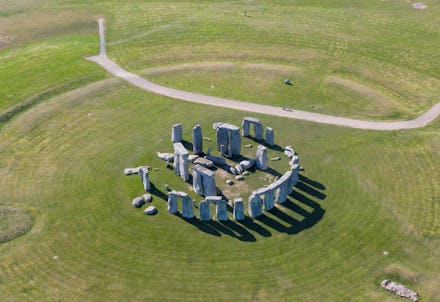A massive ring of mysterious underground shafts was just discovered near Stonehenge

Stonehenge has been keeping an enormous secret from archaeologists for all these years. Approximately two miles away from the iconic, prehistoric arrangement of massive stone slabs is a spot called Durrington Walls. It's the location of what may have been a Neolithic (late Stone Age) settlement consisting of many homes that were enclosed by a circular ditch. Researchers theorize that the builders of Stonehenge ate and lived in this village, then traveled to work on the monument. Just outside of the village were pits that were thought to be natural features — until now. On Monday, a team led by researchers with the University of Bradford published their discovery of an enormous ring of man-made shafts surrounding the settlement in Internet Archaeology. This technology-led find has shocked archaeologists and stands to change what they thought they knew about the builders of Stonehenge.
Until now, scientists thought they had uncovered most of the big finds in the Stonehenge area. But thanks to remote sensing technology, surveying, and ground sampling, they realized the pits were more than just natural hollows in the ground.
"The area around Stonehenge is amongst the most studied archaeological landscapes on earth," Professor Vincent Gaffney, of the University of Bradford, said in a statement, "and it is remarkable that the application of new technology can still lead to the discovery of such a massive prehistoric structure which, currently, is significantly larger than any comparative prehistoric monument that we know of in Britain, at least."
Gaffney and his colleagues led the study that revealed the ring of shafts. They believe there were originally 30 shafts in total, but only 20 have been found so far. Each one is about 30 feet wide and 15 feet deep, and are currently theorized to be a boundary marker that either guided people to a sacred area or warned outsiders of the location they were approaching.
"The size of the shafts and circuit surrounding Durrington Walls is currently unique," Gaffney told The Guardian. "I can't emphasize enough the effort that would have gone [into] digging such large shafts with tools of stone, wood, and bone."
It's yet another marvelous feat the builders of Stonehenge have pulled off that has stunned researchers. The Stonehenge monument itself is baffling with how accurately it's aligned with the axis of the sun to mark the winter and summer solstices by the position of the stones. There's evidence that the site was used for ceremonial or burial reasons, but there are also theories that it could've been a religious destination or a giant calendar as well. The construction of the monument is another puzzle that has continued to blow researchers' minds. Geological analysis of the stones have indicated that the rocks were obtained from locations as far away as 200 miles — how the people of the late Stone Age lugged all that heavy material to the construction site is still a mystery.
"What we're seeing is two massive monuments with their territories," Gaffney explained to The Guardian. "Other archaeologists [...] have suggested that, while Stonehenge, with its standing stones, was an area for the dead, Durrington, with its wooden structures, was for the living."
The discovery of the huge ring of shafts also provides the first evidence that Neolithic peoples were able to keep count or tally in some fashion, as researchers believe they had to do so in order to carefully position the shafts.
"[The shafts] demonstrates the significance of Durrington Walls Henge, the complexity of the monumental structures within the Stonehenge landscape, and the capacity and desire of Neolithic communities to record their cosmological belief systems in ways, and at a scale, that we had never previously anticipated," he continued.
"[The] use of a multidisciplinary effort with remote sensing and careful sampling is giving us an insight to the past that shows an even more complex society that we could ever imagine," added Dr. Richard Bates, who was also part of the research team, in a statement.
"Clearly sophisticated practices demonstrate that the people were so in tune with natural events to an extent that we can barely conceive in the modern world we live in today."